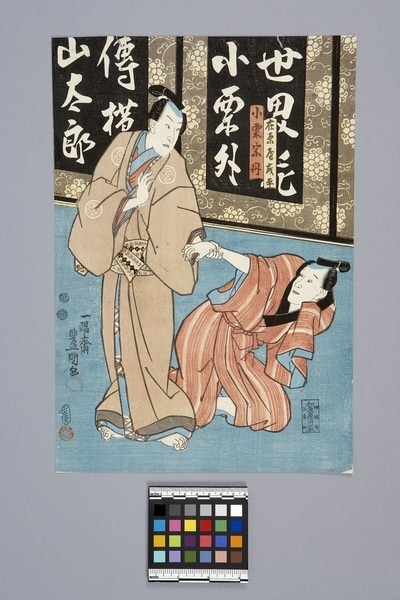Ariwaraya Narihira, Oguri Sōtan Item Number: N2.1167 from the MOA: University of British Columbia

Description
Print of two figures with a large screen in the background. The print is the right half of a pair; it would be shown with N2.1168 on the viewer's left. Together they show a scene of three figures, with a large screen in the background. This part shows a male standing figure with his face tilted down toward a man kneeling on the right side. His left hand holds the right wrist of the man on the floor. The standing male is wearing a beige kimono. The man crouching down has his head turned upward, toward the other man; he is wearing a red-orange and brown-beige striped kimono. Signed 一陽斎豊国画 (Ichiyōsai Tokukuni ga) with a red circle known as 年玉印(toshidama-in). Above the signature are two black circle censor seals known as aratame-in (改印) or kiwame-in (極印) of 米良 (Mera) and 渡邊 (Watanabe). In the lower left corner, there is an oval black censor seal of シタ賣 (shita-uri) and below is a circular red seal. In the lower right corner, there is a vertically rectangular black seal of a publisher, 和泉屋清七 (Izumiya Seishichi). The print is made of two vertically rectangular pieces, creating a horizontally rectangular image overall.
History Of Use
This type of ukiyo-e print is referred to as ōban nishiki-e (大判錦絵). Ōban refers to a print size about 24-25cm x 32-37 cm, and nishiki-e refers to multi-colored woodblock print.
Narrative
This print by Utagawa Kunisada (歌川国貞) (aka Utagawa Toyokuni III 三代目歌川豊国/豊國) is titled, Ariwaraya Narihira, Oguri Sōtan (在原屋成平 小栗宗丹), and is paired with print N2.1168. The print depicts a scene of kabuki, Sekai no hana Oguri gaiden (世界花小栗外伝) first performed in April 1851, at Nakamura-za (中村座), the oldest Edo kabuki theatre in Tokyo.
Iconographic Meaning
The standing male represents Oguri Sōtan (小栗宗丹) played by kabuki actor Nakayama Ichizō I (初代中山市蔵); the crouching man is Ariwaraya Narihira (在原屋成) played by kabuki actor Bandō Takesaburō I (初代坂東竹三郎).
Item History
- Made by Kunisada Utagawa (Maker) in Japan during 1851
- Collected between 1911 and 1930
- Owned by James Fyfe-Smith and Mary G. Fyfe-Smith
- Owned by Florence Fyfe-Smith before 1957
- Received from Florence Fyfe-Smith (Donor) during 1957
What
- Name
- Ariwaraya Narihira, Oguri Sōtan
- Identification Number
- N2.1167
- Type of Item
- Manufacturing Technique
- woodblock printed
- Overall
- height 36.0 cm, width 24.9 cm
Who
- Culture
- Japanese
- Creator
- Kunisada Utagawa (Maker)
- Previous Owner
- James Fyfe-Smith, Mary G. Fyfe-Smith and Florence Fyfe-Smith
- Received from
- Florence Fyfe-Smith (Donor)
Where
- Holding Institution
- MOA: University of British Columbia
- Made in
- Japan
When
- Creation Date
- during 1851
- Collection Date
- between 1911 and 1930
- Ownership Date
- before 1957
- Acquisition Date
- during 1957
Other
- Item Classes
- works on paper
- Condition
- good